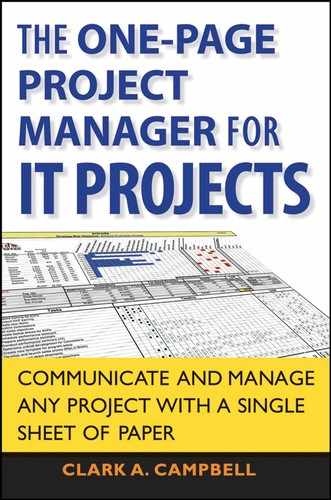Over more than a decade, the One-Page Project Manager (OPPM) grew from its fledgling ideas into a standard protocol within the confines of a single corporation. Now, with the first book exposed to the refining grist of the free market, it has found a unique and meaningful place in the discipline and profession of project management. I never could have forecast that OPPM would frequently be Amazon's #2 best-selling project management book just behind the Project Management Book of Knowledge (PMBOK), or that it would often be among the top 50 best selling of all management books.
This second book, The One-Page Project Manager for IT Projects, is in response to a growing number of inquiries concerning more specific guidance on how OPPM has in the past, and may in the future, be used specifically for IT related projects.
During the early years of project management's 40-year growth history, time lines and PERT scheduling techniques were the most commonly taught methods. Construction, engineering, defense, and aerospace were the drivers of more formal methods, with Primavera launching its project management tools in 1983. IT projects themselves began to be aggressively supported with the launch of Microsoft Project in 1990. Construction and IT projects possess both divergent and convergent requirements, broad similarities, and critical differences. Together, these have fueled much of innovation and creative development in the tools now available for today's project managers.
Einstein is reputed to have said, "Everything should be made as simple as possible, but no simpler." And with project management, the devil is certainly in the details. Project management has, of necessity, expanded its reach, its required learnings, its plethora of publications, and both its breadth and depth. Nothing illustrates this more than the PMBOK itself, connected to the reach and profound contributions of the Project Management Institute (PMI). A further manifestation is the massive functionality and expansive documentation for Microsoft Project, and Primavera, coupled with an army of training and consulting professionals ready to provide education and guidance through this complex network of knowledge.
How to communicate the complex simply—"that is the question." Dilbert posits an answer:
DILBERT: © Scott Adams/Dist. by United Feature Syndicate, Inc.

Edward Tufte is Professor Emeritus at Yale University where he taught courses in statistical evidence and information design. In his remarkable book, The Visual Display of Quantitative Information, he says, "Often the most effective way to describe, explore, and summarize a set of numbers—even a very large set—is to look at pictures of those numbers. Furthermore, of all methods for analyzing and communicating statistical information, well-designed data graphics are usually the simplest and at the same time the most powerful."
The 1848 Shaker song by Elder Joseph Brackett begins "Tis a gift to be simple, 'tis a gift to be free, 'tis a gift to come down where we ought to be." OPPM has proven to be a simple gift to those wrestling with project management communication, particularly for IT projects.
Remembering Einstein, it would only be a gift, if it was not too simple. The power and simplicity of OPPM is a combination of:
All five essential parts of a project (Tasks, Objectives, Time line, Cost, and Owners);
The linkages and alignment of each;
A clear, efficient, and accurate representation of both plan and performance;
An addition to, rather than a replacement of, current powerful project management tools; and finally
An intuitive picture that is easy to create and maintain.
Chapter 1 summarizes the content of my first book. You see how to construct and report using the One-Page Project Manager. If you are the CIO, Chapter 2 is specifically for you.
Selecting the right people for your project substantially raises your chances for success. Making those decisions poorly may doom the finest of plans. Chapter 3 presents some new ideas on the types of people essential to your project, and describes their assets, liabilities, and how to create a potent team.
The Project Management Office (PMO) can be found within the ranks of IT or it may be organized at the corporate level. Chapter 4 outlines how the OPPM supports the eight fundamental responsibilities of your PMO.
Chapters 5,6,7, and 8 provide specific examples of how OPPM was used to help plan, staff, direct, control, and communicate different IT projects. You will read about the launching of a dot-com business, the implementation of SAP, securing ISO 9000 certification, and the management of consultants.
Finally, Chapter 9 addresses some customizing ideas for OPPM—a little, but not too many.
Leonardo da Vinci said, "Simplicity is the ultimate sophistication." It has been suggested that OPPM may be the "da Vinci Code" for project management.
